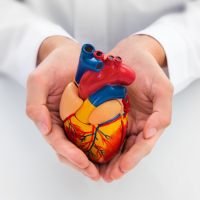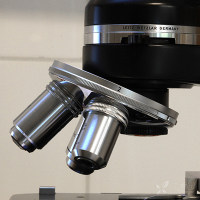【medical-news】固态系统:100美元几分钟搞定基因组测序
13:21 07 July 2010 by Duncan Graham-Rowe
Drawing individual strands of DNA through nanoscopic pores in a chip could do in a matter of minutes what the human genome project took more than a decade to achieve – sequence an entire human genome.
Known as solid state nanopore sequencing, the technique identifies DNA base pairs by measuring their electrical properties as they pass through a tiny hole – relying on the fact that DNA nucleotides each possess distinct electrical signatures. It marks a radical move away from the traditional biochemical and optical approaches to genome sequencing, and according to IBM and Roche Applied Science, who are teaming up to develop the technology, it could slash the cost of sequencing a genome from over $10,000 to as little as $100.
The technique was developed by Stanislav Polonsky's team at IBM's Watson Research Center in Yorktown Heights, New York state. They built a 10-nanometre-thick membrane, composed of three layers of titanium nitride separated by insulating layers of silica, then punched a 3-nanometre-wide hole through it.
When a voltage is applied across the membrane the negatively charged strands of DNA are drawn towards it and one passes into the pore, says Polonsky. Once trapped, the voltage is shut off and an electric field is applied across each metal layer, trapping a base pair in the central layer to identify it. Finally, by flipping the field's polarity the DNA strand is ratcheted along so the next base pair sits in the central layer for identification.
To date, the team has built the membrane and shown that DNA molecules can be drawn into the nanopore – they have yet to classify the base pairs, however. "But our modelling shows that it is doable," says Polonsky. Furthermore, preliminary unpublished experiments with DNA suggest the ratchet mechanism works, he says.
Nanopore sequencing is by no means a new idea. Research groups in the US and UK have spent 15 years developing and improving versions of the technology. In the UK, Hagan Bayley's work at the University of Oxford has spawned a company – Oxford Nanopore – that is now in the process of trying to commercialise nanopore sequencing.
But Oxford Nanopore, and others in the sector, use biological mechanisms to fashion the nanopores and thread DNA through them. Oxford Nanopore's technology involves an enzyme made from alpha hemolysin (AHL), which sits on the membrane's surface, chopping off DNA base pairs one at a time and feeding them through the pore to be measured, says the company's CEO Gordon Sanghera.
"But they cannot control the speed," says Ulrich Schwoerer of Roche Applied Science in Branford, Connecticut. "It is dependent upon the speed of the enzyme." A non-biological, solid-state approach should make it possible to process DNA strands at rates of 1000 base pairs per second, per pore – a 30-fold increase on the enzyme approach, he says. Furthermore, because pores can be packed densely, several strands could be read simultaneously.
The advantages of solid-state systems are encouraging Oxford Nanopore to explore replacing its protein pores with non-biological versions, says Sanghera – the firm has been working on such technology through a partnership with Harvard University since 2008. "If it can be made to work, this really is a significant leap in the industry," he says.
http://www.newscientist.com/article/dn19138-solidstate-systems-could-sequence-a-genome-for-100.html
=======================================
Solid-state systems could sequence a genome for $100
13:21 07 July 2010 by Duncan Graham-Rowe
固态系统:100美元几分钟搞定基因组测序
撰文:Duncan Graham-Rowe
译者:Docofsoul
《新科学家》2010年7月7日13:21报道
Drawing individual strands of DNA through nanoscopic pores in a chip could do in a matter of minutes what the human genome project took more than a decade to achieve – sequence an entire human genome.
通过吸引DNA链穿过芯片上的纳米级的孔可在几分钟内搞定人类基因组测序,而此前基因组测序计划整整耗时十年才得以完成相应的任务。
Known as solid state nanopore sequencing, the technique identifies DNA base pairs by measuring their electrical properties as they pass through a tiny hole – relying on the fact that DNA nucleotides each possess distinct electrical signatures. It marks a radical move away from the traditional biochemical and optical approaches to genome sequencing, and according to IBM and Roche Applied Science, who are teaming up to develop the technology, it could slash the cost of sequencing a genome from over $10,000 to as little as $100.
这一技术就是固态纳米孔测序:基于每个DNA核苷酸都拥有一个与众不同的电子标志(电子签名)的事实,在DNA碱基对通过一个微孔时,通过测量其电子属性即可认定DNA碱基对。这就是为什么该技术与传统的生物化学与光学的基因组测序方法迥然不同的原因;同时,根据正在组织研究小组开发这项技术的IBM与罗氏应用科学(Roche Applied Science), 有望将测量基因组成本从超过1万美元降到100美元左右。
The technique was developed by Stanislav Polonsky's team at IBM's Watson Research Center in Yorktown Heights, New York state. They built a 10-nanometre-thick membrane, composed of three layers of titanium nitride separated by insulating layers of silica, then punched a 3-nanometre-wide hole through it.
本技术由位于纽约州约克敦海茨的IBM华森研究中心Stanislav Polonsky率队的研究小组开发。他们制出了由三层氮化钛(层间是二氧化硅绝缘层)组成的10纳米厚的膜片,然后在上面打出3纳米宽的洞。
When a voltage is applied across the membrane the negatively charged strands of DNA are drawn towards it and one passes into the pore, says Polonsky. Once trapped, the voltage is shut off and an electric field is applied across each metal layer, trapping a base pair in the central layer to identify it. Finally, by flipping the field's polarity the DNA strand is ratcheted along so the next base pair sits in the central layer for identification.
Polonsky介绍说,当膜上加上电压时,带负电荷的众多DNA链就会被它所吸引,而其中一条链会穿过小孔。一旦小孔捕获了一条DNA链,电压随即关闭,然后施加电场并使电场穿透每个金属层,这样落在中间层的碱基对会被“抓住”并被“验明正身”。最后,通过翻转电场的极性,DNA链会象在棘齿上一样转动一格,下一个的碱基又被“卡”在中间层等待确认。
To date, the team has built the membrane and shown that DNA molecules can be drawn into the nanopore – they have yet to classify the base pairs, however. "But our modelling shows that it is doable," says Polonsky. Furthermore, preliminary unpublished experiments with DNA suggest the ratchet mechanism works, he says.
迄今为止,该研究小组已造出了膜片,并显示DNA分子可被引向纳米孔 —— 但是他们仍然需要界定碱基对。“不过我们的模型显示:这是可行的!”Polonsky说。他进一步指出,尚未发表的有关DNA初步实验提示棘轮机制行得通。
Nanopore sequencing is by no means a new idea. Research groups in the US and UK have spent 15 years developing and improving versions of the technology. In the UK, Hagan Bayley's work at the University of Oxford has spawned a company – Oxford Nanopore – that is now in the process of trying to commercialise nanopore sequencing.
纳米孔测序并非是新点子。美国与英国的不少研究小组已经耗时15年开发、改进这一技术的多种版本。在英国,牛津大学的Hagan Bayley的研究工作就已经催生了Oxford Nanopore(即“牛津纳米孔”)公司,该公司目前正处于将纳米孔测序技术商业化的进程中。
But Oxford Nanopore, and others in the sector, use biological mechanisms to fashion the nanopores and thread DNA through them. Oxford Nanopore's technology involves an enzyme made from alpha hemolysin (AHL), which sits on the membrane's surface, chopping off DNA base pairs one at a time and feeding them through the pore to be measured, says the company's CEO Gordon Sanghera.
但Oxford Nanopore与这个领域的其它公司(或研究小组)所运用的是生物机制,以此来形成纳米孔并让DNA链穿越纳米孔。Oxford Nanopore公司的执行总裁Gordon Sanghera介绍说,该公司的技术与制造自α-溶血素(AHL)的酶有关。将酶置于膜的表面切开DNA的碱基对,一次一个,然后把他们送到孔里测量。
"But they cannot control the speed," says Ulrich Schwoerer of Roche Applied Science in Branford, Connecticut. "It is dependent upon the speed of the enzyme." A non-biological, solid-state approach should make it possible to process DNA strands at rates of 1000 base pairs per second, per pore – a 30-fold increase on the enzyme approach, he says. Furthermore, because pores can be packed densely, several strands could be read simultaneously.
“但是该公司无法控制相关速度,”位于美国康州布兰福德的罗氏应用科学(Roche Applied Science)的Ulrich Schwoerer说,“因为这种速度取决于酶切的速度。”他又指出,一种非生物、固态方法则应该可以每秒每孔处理DNA链的1000个碱基对,这是酶切速度的30倍。更进一步的是,因为孔可以被密集堆砌,因此可以同时处理几条DNA链。
The advantages of solid-state systems are encouraging Oxford Nanopore to explore replacing its protein pores with non-biological versions, says Sanghera – the firm has been working on such technology through a partnership with Harvard University since 2008. "If it can be made to work, this really is a significant leap in the industry," he says.
Sanghera说,意识到固体系统的优势,Oxford Nanopore公司正在探索用非生物版本来替代其蛋白孔的方法。实际上,该公司自2008年起就已经通过与哈佛大学的合作关系探索这种技术。“如果探索成功的话,那肯定是本行业的一次重大进步。”他说。
(Docofsoul译于 2010-7-8)
================================================
撰文:Duncan Graham-Rowe
译者:Docofsoul
《新科学家》2010年7月7日13:21报道
通过吸引DNA链穿过芯片上的纳米级的孔可在几分钟内搞定人类基因组测序,而此前基因组测序计划整整耗时十年才得以完成相应的任务。
这一技术就是固态纳米孔测序:基于每个DNA核苷酸都拥有一个与众不同的电子标志(电子签名)的事实,在DNA碱基对通过一个微孔时,通过测量其电子属性即可认定DNA碱基对。这就是为什么该技术与传统的生物化学与光学的基因组测序方法迥然不同的原因;同时,根据正在组织研究小组开发这项技术的IBM与罗氏应用科学(Roche Applied Science), 有望将测量基因组成本从超过1万美元降到100美元左右。
本技术由位于纽约州约克敦海茨的IBM华森研究中心Stanislav Polonsky率队的研究小组开发。他们制出了由三层氮化钛(层间是二氧化硅绝缘层)组成的10纳米厚的膜片,然后在上面打出3纳米宽的洞。
Polonsky介绍说,当膜上加上电压时,带负电荷的众多DNA链就会被它所吸引,而其中一条链会穿过小孔。一旦小孔捕获了一条DNA链,电压随即关闭,然后施加电场并使电场穿透每个金属层,这样落在中间层的碱基对会被“抓住”并被“验明正身”。最后,通过翻转电场的极性,DNA链会象在棘齿上一样转动一格,下一个的碱基又被“卡”在中间层等待确认。
迄今为止,该研究小组已造出了膜片,并显示DNA分子可被引向纳米孔 —— 但是他们仍然需要界定碱基对。“不过我们的模型显示:这是可行的!”Polonsky说。他进一步指出,尚未发表的有关DNA初步实验提示棘轮机制行得通。
纳米孔测序并非是新点子。美国与英国的不少研究小组已经耗时15年开发、改进这一技术的多种版本。在英国,牛津大学的Hagan Bayley的研究工作就已经催生了Oxford Nanopore(即“牛津纳米孔”)公司,该公司目前正处于将纳米孔测序技术商业化的进程中。
但Oxford Nanopore与这个领域的其它公司(或研究小组)所运用的是生物机制,以此来形成纳米孔并让DNA链穿越纳米孔。Oxford Nanopore公司的执行总裁Gordon Sanghera介绍说,该公司的技术与制造自α-溶血素(AHL)的酶有关。将酶置于膜的表面切开DNA的碱基对,一次一个,然后把他们送到孔里测量。
“但是该公司无法控制相关速度,”位于美国康州布兰福德的罗氏应用科学(Roche Applied Science)的Ulrich Schwoerer说,“因为这种速度取决于酶切的速度。”他又指出,一种非生物、固态方法则应该可以每秒每孔处理DNA链的1000个碱基对,这是酶切速度的30倍。更进一步的是,因为孔可以被密集堆砌,因此可以同时处理几条DNA链。
Sanghera说,意识到固体系统的优势,Oxford Nanopore公司正在探索用非生物版本来替代其蛋白孔的方法。实际上,该公司自2008年起就已经通过与哈佛大学的合作关系探索这种技术。“如果探索成功的话,那肯定是本行业的一次重大进步。”他说。
(Docofsoul译于 2010-7-8)
译后中文字数为1015个。















































